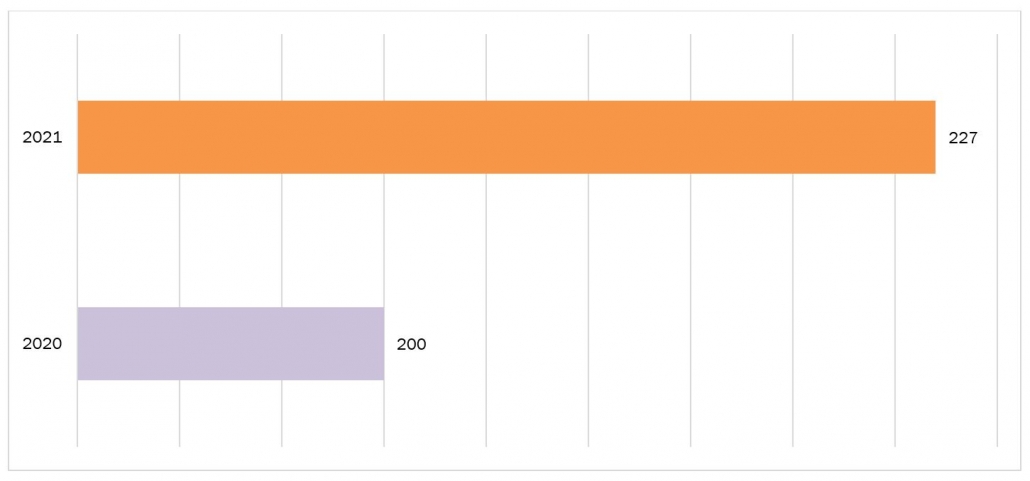5.5G: A Roadmap To 6G
5G’s fundamental purpose is to facilitate connectivity among individuals. Originally designed to ensure continuous communication anytime and anywhere, 5G is expected to evolve further by 2030. During this evolution, 5G will play an increasingly significant role in enabling real-time interaction with the virtual world, offering users a fully immersive experience. The integration of 5G with virtual reality (VR) and augmented reality (AR) technologies has transformed the interaction between the physical and virtual realms into a tangible reality. However, to achieve an advanced XR Pro and holographic experience, cellular communication must provide higher speeds. The average access speed, currently supporting 4K video streaming at 120 Mbit/s, needs to rise to 2 Gbit/s for seamless 16K video. Additionally, a reduction in interaction latency from the existing 20 MS to 5 MS will be essential. Meeting these demands necessitates the continuous evolution of 5G technology.
Enhancing human connectivity experiences and refining interactions among connected devices are imperative. In anticipation of the time when 5G will facilitate a staggering 100 billion connections, Huawei has outlined its vision for 5.5G. The company aims to actively influence the growth and progression of the 5G industry, infusing greater dynamism into 5G technology. The goal is to generate fresh value, contributing to societal development and advancements in various industries.
The progression of 5G, commencing with Release 18, is referred to as 5G Advanced. The standardization of 5G Advanced marks a significant milestone in the development of cellular wireless access, paving the way toward 6G. The major key advancements in 5G-Advanced or 5.5G are:
- Extended XR (AR, VR, gaming) Capabilities: 5G-Advanced is set to elevate the current XR experience by broadening the accessibility of VR, immersive AR applications, and cloud gaming. It promises users an enhanced XR experience while on the move, requiring high data rates with precise latency constraints and a heightened level of application awareness. The improved application awareness facilitates the transfer of XR processing load from devices to the network, reducing costs, size, and power consumption of user equipment. This transition may replace bulkier devices with more compact, pocket-sized models, enabling XR applications in diverse settings.
- Improved Coverage and MIMO Performance: 5G-Advanced aims to meet the rising demand for uplink-intensive applications, such as high-quality live video streaming. Anticipated to offer 20% higher data rates compared to 5G through innovative approaches, it will also address lower uplink latencies. Low latencies in both link directions are crucial for optimal end-user experience in XR applications, and 5G-Advanced is expected to enhance uplink coverage.
- 5G Replacing GSM-R: 5G-Advanced will extend to specialized vertical use cases across sectors, including railways, utilities, and public safety. It involves deploying NR in dedicated spectrum bandwidths below 5MHz. For instance, the Future Railway Mobile Communication System (FRMCS) in Europe, replacing GSM-R, will utilize 5G NR for next-generation signaling and communications in railways.
- Evolution Beyond Smartphones: 5G-Advanced will usher in a new era of devices benefiting from the extensive coverage and efficient connectivity of 5G. Beyond smartphones, a variety of new full-capability and Reduced Capability (RedCap) devices are expected. RedCap devices, designed for specific use cases like industrial quality control, process monitoring, and asset tracking, offer significantly lower costs. Full-capability devices like drones, autonomous vehicles, robots, and Automated Ground Vehicles (AGVs) will thrive in 5G-Advanced networks, ensuring reliable communications with base stations.
5G Advanced continues to push the boundaries of spectral efficiency, both in sub-7 GHz and mmWave spectrum. Advancements in Multiple-Input-Multiple-Output (MIMO), including increased support for DMRS2 ports and MIMO layers, will enhance both uplink and downlink transmission performance. Release 18 is set to introduce an intelligent air interface design, with an initial focus on cross-node machine learning for CSF3 to reduce communication overhead, leading to improved capacity and throughput, as demonstrated in advanced over-the-air scenarios. Efforts toward a full-duplex system aim to enhance capacity and reduce latency, particularly in the uplink. Additional improvements, such as multicast reception in inactive mode, have the potential to enhance device efficiency when delivering content simultaneously to multiple devices.
5G Advanced is focused on creating more environmentally friendly networks and devices. This involves examining the energy consumption models of core infrastructure elements such as base stations and continuing efforts to decrease device power consumption. Release 18 aims to establish an evaluation model with associated Key Performance Indicators (KPIs) to measure system energy consumption performance and explore various power-saving techniques. The goal is to enhance energy efficiency across a range of system deployment scenarios. Additionally, ongoing efforts involve introducing a new, highly efficient design for Wake-Up Signal (WUS5) to significantly reduce the power consumption of devices in inactive mode.
5G Advanced introduces architectural enhancements to facilitate intelligent network automation, encompassing RAN management, analytics, and the life-cycle management of AI/ML models. This includes measures to enhance the accuracy of models. Additionally, 5G Advanced supports intent-based management to streamline network management processes. The developments in the 5G Core (5GC) architecture regarding analytics and data collection establish a robust foundation for AI/ML-driven decisions within 5GC Network Functions (NFs). Release 18 has introduced features such as Network Data Analytics Function-assisted (NWDAF-assisted) generation of User Equipment (UE) policy for network slicing. In this context, the Policy Control Function (PCF) is supported by slice load analytics, enabling the PCF to adjust the UE Route Selection Policy (URSP) rules. Release 18 also enhances analytics capabilities, including the provision of finer-grained location information than a cell level.
5G systems are rapidly being deployed, providing high-speed, low-latency connectivity for various services. The ongoing transformation poses challenges that extend beyond the capabilities of 5G and 5G Advanced. The industry and research community are setting a clear target for 6G to contribute to an efficient, human-friendly, and sustainable society through ubiquitous intelligent communication. Some of the advanced technologies discussed in 5G can be viewed as precursors to certain 6G building blocks.
As per the National Association of Software and Service Companies (NASSCOM), India’s technology sector achieved unprecedented growth, reaching a revenue of $227 billion in 2021, compared to $200 billion in the previous year. This growth in India’s digital economy outpaced the overall Indian GDP, establishing strong connections with non-digital sectors. Contributing substantially to the development of 6G standards would not only benefit the domestic sector but also elevate India’s position in the global telecommunications industry. Prioritizing the adoption of 6G could position India as a global provider of intellectual property and offer cost-effective products and solutions.
Figure 1: Growth of India’s Technology Sector, From 2020 to 2021, in US$ Billion

Source: International Trade Administration
On October 11, 2023, during the Global Mobile Broadband Forum (MBBF 2023), Cao Ming, who serves as the President of Wireless Solutions at Huawei, introduced a groundbreaking development in the telecommunications industry – the inaugural comprehensive suite of solutions for 5.5G. This marks a significant milestone in the evolution of mobile broadband technology, showcasing Huawei’s commitment to pushing the boundaries and ushering in the era of 5.5G connectivity. The introduction of this full series of solutions demonstrates Huawei’s leadership in driving advancements in wireless communication and further solidifies its position at the forefront of the telecommunications landscape.
On October 18, 2023, Digital Nasional Berhad (DNB), TM, and ZTE Corporation (ZTE) announced a strategic collaboration to introduce the fastest 5G live trial globally, achieving impressive speeds of up to 28Gbps. The incorporation of mmWave spectrum within DNB’s 5G wholesale network enhances this initiative, providing users with a transformative 5.5G experience, setting the stage for the future transition to 6G. This pioneering technology is poised to revolutionize Malaysia’s digital landscape and set a new international benchmark for wireless communication standards.
The 5G evolution, commencing with Release 18, is denoted as 5G Advanced. This label signifies the culmination of value derived from the continuous progression of 5G since 2018, building upon the foundations established in Releases 15, 16, and 17. Release 18 brings about both architectural enhancements and additional capabilities catering to emerging market segments. The deployment of 5G systems is proceeding swiftly, delivering high-speed, low-latency connectivity for a diverse array of services. The introduction of new services, such as advanced Extended Reality (XR) services, raises expectations for network performance. Support for Reduced Capability (RedCap) will expand the scope of machine-type communication. Applications requiring real-time networking using IP will benefit from Deterministic Networking, offering bounded low latency, low delay variation, and extremely low loss. To efficiently address these demands, service providers will increasingly utilize AI/ML and network automation, simultaneously focusing on reducing energy consumption. 3GPP must concentrate on these areas within the framework of 5G Advanced, as service providers prepare to capitalize on the advantages offered by 5G Advanced systems. These technological components also serve as crucial precursors to several building blocks of 6G.
Find some of our related studies:
- 5G Segment Routing Market: https://www.knowledge-sourcing.com/report/5g-segment-routing-market
- 5G Public Cloud Market: https://www.knowledge-sourcing.com/report/5g-public-cloud-market
- 5G Mobile Core Network (MCN) Market: https://www.knowledge-sourcing.com/report/5g-mobile-core-network-mcn-market



